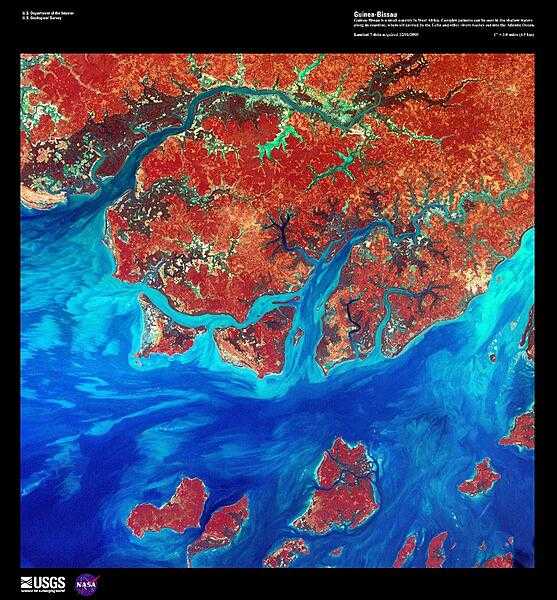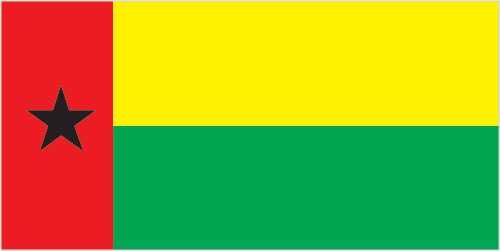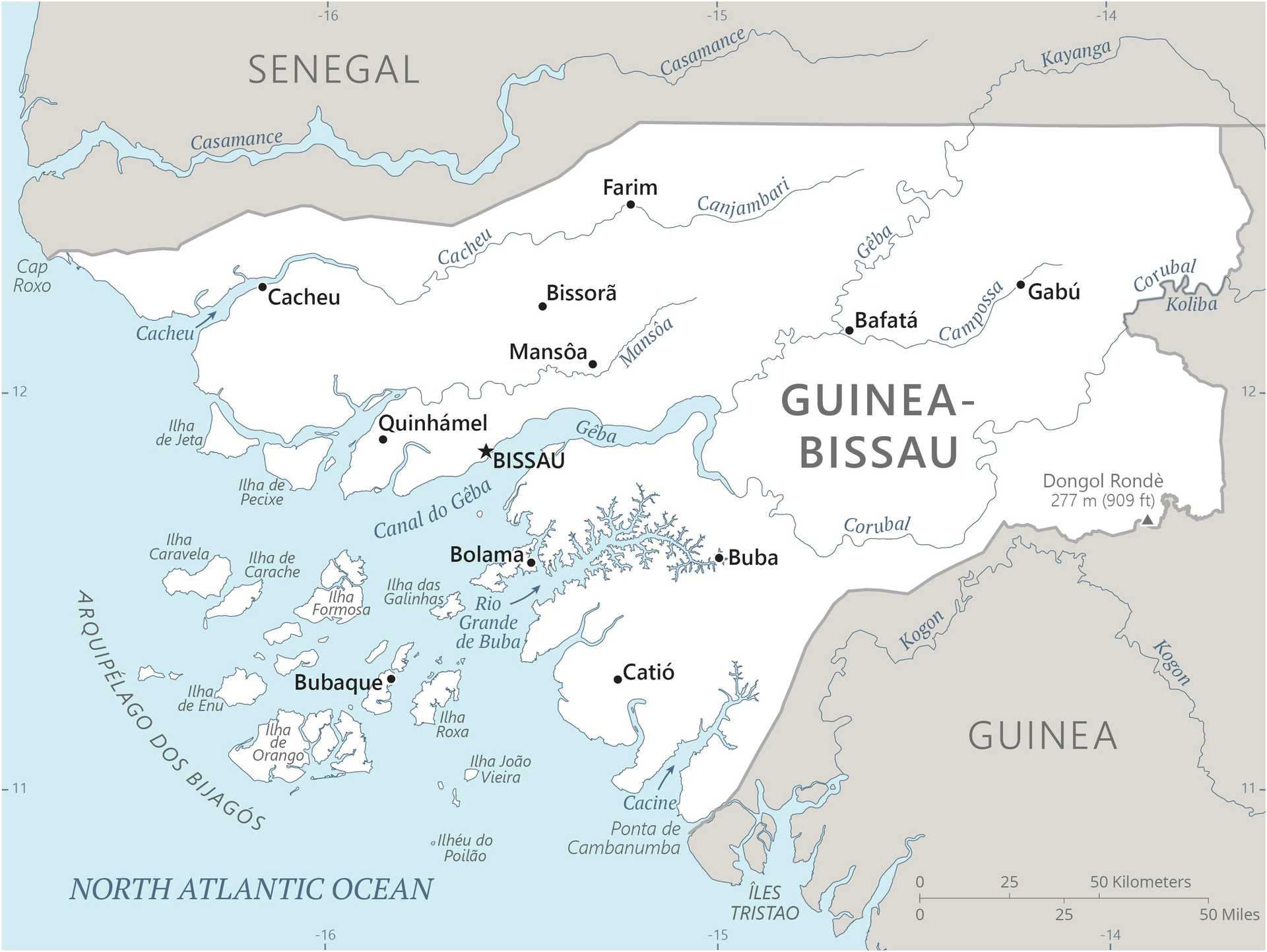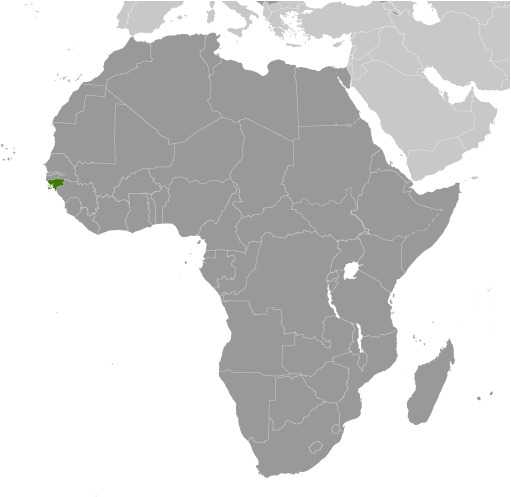Introduction
Background
For much of its history, Guinea-Bissau was under the control of the Mali Empire and the Kaabu Kingdom. In the 16th century, Portugal began establishing trading posts along Guinea-Bissau’s shoreline. Initially, the Portuguese were restricted to the coastline and islands. However, the slave and gold trades were lucrative to local African leaders, and the Portuguese were slowly able to expand their power and influence inland. Starting in the 18th century, the Mali Empire and Kingdom of Kaabu slowly disintegrated into smaller local entities. By the 19th century, Portugal had fully incorporated Guinea-Bissau into its empire.
Since gaining independence in 1974, Guinea-Bissau has experienced considerable political and military upheaval. In 1980, a military coup established General Joao Bernardo 'Nino' VIEIRA as president. VIEIRA's regime suppressed political opposition and purged political rivals. Several coup attempts through the 1980s and early 1990s failed to unseat him, but a military mutiny and civil war in 1999 led to VIEIRA's ouster. In 2000, a transitional government turned over power to opposition leader Kumba YALA. In 2003, a bloodless military coup overthrew YALA and installed businessman Henrique ROSA as interim president. In 2005, VIEIRA was reelected, pledging to pursue economic development and national reconciliation; he was assassinated in 2009. Malam Bacai SANHA was then elected president, but he passed away in 2012 from a long-term illness. A military coup blocked the second round of the election to replace him, but after mediation from the Economic Community of Western African States, a civilian transitional government assumed power. In 2014, Jose Mario VAZ was elected president in a free and fair election, and in 2019, he became the first president in Guinea-Bissau’s history to complete a full term. Umaro Sissoco EMBALO was elected president in 2019, but he did not take office until 2020 because of a prolonged challenge to the election results.
Visit the Definitions and Notes page to view a description of each topic.
Geography
Location
Western Africa, bordering the North Atlantic Ocean, between Guinea and Senegal
Geographic coordinates
12 00 N, 15 00 W
Map references
Africa
Area - comparative
slightly less than three times the size of Connecticut
Land boundaries
total: 762 km
border countries (2): Guinea 421 km; Senegal 341 km
Coastline
350 km
Maritime claims
territorial sea: 12 nm
exclusive economic zone: 200 nm
Climate
tropical; generally hot and humid; monsoonal-type rainy season (June to November) with southwesterly winds; dry season (December to May) with northeasterly harmattan winds
Terrain
mostly low-lying coastal plain with a deeply indented estuarine coastline rising to savanna in east; numerous off-shore islands including the Arquipelago Dos Bijagos consisting of 18 main islands and many small islets
Elevation
highest point: Dongol Ronde 277 m
lowest point: Atlantic Ocean 0 m
mean elevation: 70 m
Natural resources
fish, timber, phosphates, bauxite, clay, granite, limestone, unexploited deposits of petroleum
Land use
agricultural land: 44.8% (2018 est.)
arable land: 8.2% (2018 est.)
permanent crops: 6.9% (2018 est.)
permanent pasture: 29.7% (2018 est.)
forest: 55.2% (2018 est.)
other: 0% (2018 est.)
Irrigated land
250 sq km (2012)
Major aquifers
Senegalo-Mauritanian Basin
Population distribution
approximately one-fifth of the population lives in the capital city of Bissau along the Atlantic coast; the remainder is distributed among the eight other, mainly rural, regions as shown in this population distribution map
Natural hazards
hot, dry, dusty harmattan haze may reduce visibility during dry season; brush fires
Geography - note
this small country is swampy along its western coast and low-lying inland
People and Society
Population
total: 2,132,325
male: 1,042,910
female: 1,089,415 (2024 est.)
comparison rankings: female 147; male 151; total 150
Nationality
noun: Bissau-Guinean(s)
adjective: Bissau-Guinean
Ethnic groups
Balanta 30%, Fulani 30%, Manjaco 14%, Mandinga 13%, Papel 7%, unspecified smaller ethnic groups 6% (2015 est.)
Languages
Portuguese-based Creole, Portuguese (official; largely used as a second or third language), Pular (a Fula language), Mandingo
Religions
Muslim 46.1%, folk religions 30.6%, Christian 18.9%, other or unaffiliated 4.4% (2020 est.)
Demographic profile
Guinea-Bissau’s young and growing population is sustained by high fertility; approximately 60% of the population is under the age of 25 as of 2020. Its large reproductive-age population and total fertility rate of more than 4 children per woman offsets the country’s high infant and maternal mortality rates. The latter is among the world’s highest because of the prevalence of early childbearing, a lack of birth spacing, the high percentage of births outside of health care facilities, and a shortage of medicines and supplies.
Guinea-Bissau’s history of political instability, a civil war, and several coups (the latest in 2012) have resulted in a fragile state with a weak economy, high unemployment, rampant corruption, widespread poverty, and thriving drug and child trafficking. With the country lacking educational infrastructure, school funding and materials, and qualified teachers, and with the cultural emphasis placed on religious education, parents frequently send boys to study in residential Koranic schools (daaras) in Senegal and The Gambia. They often are extremely deprived and are forced into street begging or agricultural work by marabouts (Muslim religious teachers), who enrich themselves at the expense of the children. Boys who leave their marabouts often end up on the streets of Dakar or other large Senegalese towns and are vulnerable to even worse abuse.
Some young men lacking in education and job prospects become involved in the flourishing international drug trade. Local drug use and associated violent crime are growing.
Age structure
0-14 years: 42.3% (male 453,513/female 448,514)
15-64 years: 54.6% (male 561,868/female 602,280)
65 years and over: 3.1% (2024 est.) (male 27,529/female 38,621)
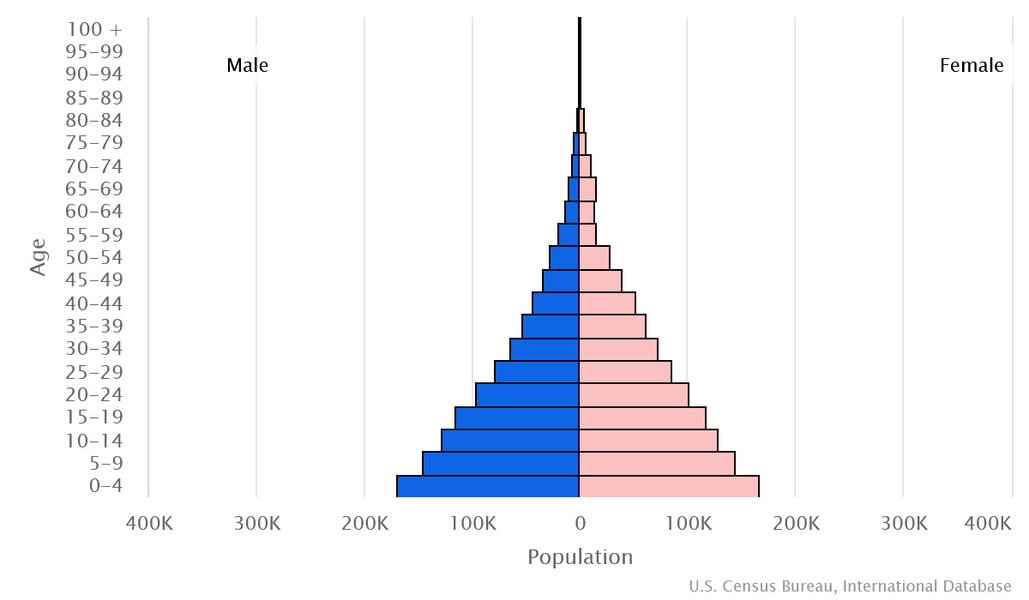
Dependency ratios
total dependency ratio: 76.6
youth dependency ratio: 71.6
elderly dependency ratio: 5
potential support ratio: 20.1 (2021 est.)
Median age
total: 18.4 years (2024 est.)
male: 17.8 years
female: 18.9 years
comparison ranking: total 221
Population distribution
approximately one-fifth of the population lives in the capital city of Bissau along the Atlantic coast; the remainder is distributed among the eight other, mainly rural, regions as shown in this population distribution map
Urbanization
urban population: 45.5% of total population (2023)
rate of urbanization: 3.22% annual rate of change (2020-25 est.)
Major urban areas - population
664,000 BISSAU (capital) (2023)
Sex ratio
at birth: 1.03 male(s)/female
0-14 years: 1.01 male(s)/female
15-64 years: 0.93 male(s)/female
65 years and over: 0.71 male(s)/female
total population: 0.96 male(s)/female (2024 est.)
Infant mortality rate
total: 46.4 deaths/1,000 live births (2024 est.)
male: 52 deaths/1,000 live births
female: 40.6 deaths/1,000 live births
comparison ranking: total 22
Life expectancy at birth
total population: 64.5 years (2024 est.)
male: 62.2 years
female: 66.8 years
comparison ranking: total population 207
Gross reproduction rate
2.28 (2024 est.)
Contraceptive prevalence rate
20.6% (2018/19)
Drinking water source
improved: urban: 90.6% of population
rural: 59.1% of population
total: 73.1% of population
unimproved: urban: 9.4% of population
rural: 40.9% of population
total: 26.9% of population (2020 est.)
Current health expenditure
8.4% of GDP (2020)
Physician density
0.2 physicians/1,000 population (2020)
Sanitation facility access
improved: urban: 62.4% of population
rural: 7.6% of population
total: 31.8% of population
unimproved: urban: 37.6% of population
rural: 92.4% of population
total: 68.2% of population (2020 est.)
Major infectious diseases
degree of risk: very high (2023)
food or waterborne diseases: bacterial and protozoal diarrhea, hepatitis A, and typhoid fever
vectorborne diseases: malaria, dengue fever, and sexually transmitted diseases: hepatitis B (2024)
water contact diseases: schistosomiasis
animal contact diseases: rabies
Alcohol consumption per capita
total: 3.21 liters of pure alcohol (2019 est.)
beer: 0.41 liters of pure alcohol (2019 est.)
wine: 0.98 liters of pure alcohol (2019 est.)
spirits: 0.54 liters of pure alcohol (2019 est.)
other alcohols: 1.28 liters of pure alcohol (2019 est.)
comparison ranking: total 108
Tobacco use
total: 9% (2020 est.)
male: 17% (2020 est.)
female: 0.9% (2020 est.)
comparison ranking: total 139
Currently married women (ages 15-49)
56.7% (2023 est.)
Child marriage
women married by age 15: 8.1%
women married by age 18: 25.7%
men married by age 18: 2.2% (2019 est.)
Literacy
definition: age 15 and over can read and write
total population: 52.9%
male: 67%
female: 39.9% (2021)
Environment
Environment - current issues
deforestation (rampant felling of trees for timber and agricultural purposes); soil erosion; overgrazing; overfishing
Environment - international agreements
party to: Biodiversity, Climate Change, Climate Change-Kyoto Protocol, Climate Change-Paris Agreement, Comprehensive Nuclear Test Ban, Desertification, Endangered Species, Hazardous Wastes, Law of the Sea, Nuclear Test Ban, Ozone Layer Protection, Ship Pollution, Wetlands, Whaling
signed, but not ratified: none of the selected agreements
Climate
tropical; generally hot and humid; monsoonal-type rainy season (June to November) with southwesterly winds; dry season (December to May) with northeasterly harmattan winds
Land use
agricultural land: 44.8% (2018 est.)
arable land: 8.2% (2018 est.)
permanent crops: 6.9% (2018 est.)
permanent pasture: 29.7% (2018 est.)
forest: 55.2% (2018 est.)
other: 0% (2018 est.)
Urbanization
urban population: 45.5% of total population (2023)
rate of urbanization: 3.22% annual rate of change (2020-25 est.)
Air pollutants
particulate matter emissions: 34.85 micrograms per cubic meter (2019 est.)
carbon dioxide emissions: 0.29 megatons (2016 est.)
methane emissions: 1.46 megatons (2020 est.)
Waste and recycling
municipal solid waste generated annually: 289,514 tons (2015 est.)
Major aquifers
Senegalo-Mauritanian Basin
Total water withdrawal
municipal: 30 million cubic meters (2020 est.)
industrial: 10 million cubic meters (2020 est.)
agricultural: 140 million cubic meters (2020 est.)
Total renewable water resources
31.4 billion cubic meters (2020 est.)
Government
Country name
conventional long form: Republic of Guinea-Bissau
conventional short form: Guinea-Bissau
local long form: Republica da Guine-Bissau
local short form: Guine-Bissau
former: Portuguese Guinea
etymology: the country is named after the Guinea region of West Africa that lies along the Gulf of Guinea and stretches north to the Sahel; "Bissau," the name of the capital city, distinguishes the country from neighboring Guinea
Government type
semi-presidential republic
Capital
name: Bissau
geographic coordinates: 11 51 N, 15 35 W
time difference: UTC 0 (5 hours ahead of Washington, DC, during Standard Time)
etymology: the meaning of Bissau is uncertain, it might be an alternative name for the Papel people who live in the area of the city of Bissau
Administrative divisions
9 regions (regioes, singular - regiao); Bafata, Biombo, Bissau, Bolama/Bijagos, Cacheu, Gabu, Oio, Quinara, Tombali
Independence
24 September 1973 (declared); 10 September 1974 (from Portugal)
National holiday
Independence Day, 24 September (1973)
Legal system
mixed legal system of civil law, which incorporated Portuguese law at independence and influenced by Economic Community of West African States (ECOWAS), West African Economic and Monetary Union (UEMOA), African Francophone Public Law, and customary law
Constitution
history: promulgated 16 May 1984; note - constitution suspended following military coup April 2012, restored 2014; note - in May 2020, President EMBALO established a commission to draft a revised constitution
amendments: proposed by the National People’s Assembly if supported by at least one third of its members, by the Council of State (a presidential consultant body), or by the government; passage requires approval by at least two-thirds majority vote of the Assembly; constitutional articles on the republican and secular form of government and national sovereignty cannot be amended; amended 1991, 1993, 1996
International law organization participation
accepts compulsory ICJ jurisdiction; non-party state to the ICCt
Citizenship
citizenship by birth: yes
citizenship by descent only: yes
dual citizenship recognized: no
residency requirement for naturalization: 5 years
Suffrage
18 years of age; universal
Executive branch
chief of state: President Umaro Sissoco EMBALO (since 27 February 2020)
head of government: Prime Minister Rui Duarte DE BARROS (since 20 December 2023)
cabinet: Cabinet nominated by the prime minister, appointed by the president
elections/appointments: president directly elected by absolute majority popular vote in 2 rounds if needed for up to 2 consecutive 5-year terms; election last held on 24 November 2019 with a runoff on 29 December 2019 (next to be held in 2024); prime minister appointed by the president after consultation with party leaders in the National People's Assembly; note - the president cannot apply for a third consecutive term; note - President EMBALO was declared winner of the 29 December 2019 runoff presidential election by the electoral commission; in late February 2020, EMBALO inaugurated himself with only military leadership present, even though the Supreme Court of Justice had yet to rule on an electoral litigation appeal lodged by his political rival Domingos Simoes PEREIRA
election results:
2019: Umaro Sissoco EMBALO elected president in second round; percent of vote in first round - Domingos Simoes PEREIRA (PAIGC) 40.1%, Umaro Sissoco EMBALO (Madem G15) 27.7%, Nuno Gomez NABIAM (APU-PDGB) 13.2%, Jose Mario VAZ (independent) 12.4%, other 6.6%; percent of vote in second round - Umaro Sissoco EMBALO 53.6%, Domingos Simoes PEREIRA 46.5%
2014: Jose Mario VAZ elected president in second round; percent of vote in first round - Jose Mario VAZ (PAIGC) 41%, Nuno Gomez NABIAM (independent) 25.1%, other 33.9%; percent of vote in second round - Jose Mario VAZ 61.9%, Nuno Gomez NABIAM 38.1% (2019)
Legislative branch
description: unicameral National People's Assembly or Assembleia Nacional Popular (102 seats; 100 members directly elected in 27 multi-seat constituencies by closed party-list proportional representation vote and 2 elected in single-seat constituencies for citizens living abroad (Africa 1, Europe 1); all members serve 4-year terms)
elections: last held on 4 June 2023 (next to be held on 30 June 2027); note - on 4 December 2023 the president dissolved the parliament with new elections to be held at a future date
election results: percent of vote by party - PAIGC 39.4%, Madem G-15 21.1%, PRS 14.9%, other 12.5%; seats by party - PAIGC 54, Madem G-15 29, PRS- 12, other 7; composition - men 92, women 10, percentage women 9.8%
Judicial branch
highest court(s): Supreme Court or Supremo Tribunal de Justica (consists of 9 judges and organized into Civil, Criminal, and Social and Administrative Disputes Chambers); note - the Supreme Court has both appellate and constitutional jurisdiction
judge selection and term of office: judges nominated by the Higher Council of the Magistrate, a major government organ responsible for judge appointments, dismissals, and judiciary discipline; judges appointed by the president for life
subordinate courts: Appeals Court; regional (first instance) courts; military court
Political parties
African Party for the Independence of Guinea and Cabo Verde or PAIGC
Democratic Convergence Party or PCD
Movement for Democratic Alternation Group of 15 or MADEM-G15
National People’s Assembly – Democratic Party of Guinea Bissau or APU-PDGB
New Democracy Party or PND
Party for Social Renewal or PRS
Republican Party for Independence and Development or PRID
Union for Change or UM
International organization participation
ACP, AfDB, AOSIS, AU, CPLP, ECOWAS, FAO, FZ, G-77, IBRD, ICAO, ICRM, IDA, IDB, IFAD, IFC, IFRCS, ILO, IMF, IMO, Interpol, IOC, IOM, IPU, ITSO, ITU, ITUC (NGOs), MIGA, MINUSMA, NAM, OIC, OIF, OPCW, UN, UNCTAD, UNESCO, UNIDO, UNWTO, UPU, WADB (regional), WAEMU, WCO, WFTU (NGOs), WHO, WIPO, WMO, WTO
Diplomatic representation in the US
none
Note: Guinea-Bissau does not have official representation in Washington, DC
Diplomatic representation from the US
chief of mission: Ambassador Michael RAYNOR (since 20 April 2022)
mailing address: 2080 Bissau Place, Washington DC 20521-2080
email address and website:
dakarACS@state.gov
https://gw.usmission.gov/
Flag description
two equal horizontal bands of yellow (top) and green with a vertical red band on the hoist side; there is a black five-pointed star centered in the red band; yellow symbolizes the sun; green denotes hope; red represents blood shed during the struggle for independence; the black star stands for African unity
note: uses the popular Pan-African colors of Ethiopia; the flag design was heavily influenced by the Ghanaian flag
National symbol(s)
black star; national colors: red, yellow, green, black
National anthem
name: "Esta e a Nossa Patria Bem Amada" (This Is Our Beloved Country)
lyrics/music: Amilcar Lopes CABRAL/XIAO He
note: adopted 1974; a delegation from then Portuguese Guinea visited China in 1963 and heard music by XIAO He; Amilcar Lopes CABRAL, the leader of Guinea-Bissau's independence movement, asked the composer to create a piece that would inspire his people to struggle for independence
Economy
Economic overview
extremely poor West African economy; ethnically diverse labor force; increasing government expenditures; slight inflation due to food supply disruptions; major cashew exporter; systemic banking instabilities and corruption; vulnerable to oil price shocks
Real GDP (purchasing power parity)
$5.099 billion (2023 est.)
$4.892 billion (2022 est.)
$4.694 billion (2021 est.)
note: data in 2021 dollars
comparison ranking: 184
Real GDP growth rate
4.25% (2023 est.)
4.2% (2022 est.)
6.4% (2021 est.)
note: annual GDP % growth based on constant local currency
comparison ranking: 71
Real GDP per capita
$2,400 (2023 est.)
$2,300 (2022 est.)
$2,300 (2021 est.)
note: data in 2021 dollars
comparison ranking: 207
GDP (official exchange rate)
$1.966 billion (2023 est.)
note: data in current dollars at official exchange rate
Inflation rate (consumer prices)
9.39% (2022 est.)
2.24% (2021 est.)
1.14% (2020 est.)
note: annual % change based on consumer prices
comparison ranking: 172
GDP - composition, by sector of origin
agriculture: 50% (2017 est.)
industry: 13.1% (2017 est.)
services: 36.9% (2017 est.)
comparison rankings: services 217; industry 191; agriculture 4
GDP - composition, by end use
household consumption: 83.9% (2017 est.)
government consumption: 12% (2017 est.)
investment in fixed capital: 4.1% (2017 est.)
investment in inventories: 0.2% (2017 est.)
exports of goods and services: 26.4% (2017 est.)
imports of goods and services: -26.5% (2017 est.)
Agricultural products
rice, groundnuts, cashews, root vegetables, oil palm fruit, plantains, cassava, vegetables, sweet potatoes, coconuts (2022)
note: top ten agricultural products based on tonnage
Industries
agricultural products processing, beer, soft drinks
Industrial production growth rate
4% (2023 est.)
note: annual % change in industrial value added based on constant local currency
comparison ranking: 78
Labor force
726,000 (2023 est.)
note: number of people ages 15 or older who are employed or seeking work
comparison ranking: 154
Unemployment rate
3.18% (2023 est.)
3.2% (2022 est.)
3.63% (2021 est.)
note: % of labor force seeking employment
comparison ranking: 54
Youth unemployment rate (ages 15-24)
total: 4% (2023 est.)
male: 3.9% (2023 est.)
female: 4.2% (2023 est.)
note: % of labor force ages 15-24 seeking employment
comparison ranking: total 185
Population below poverty line
47.7% (2018 est.)
note: % of population with income below national poverty line
Gini Index coefficient - distribution of family income
33.4 (2021 est.)
note: index (0-100) of income distribution; higher values represent greater inequality
comparison ranking: 98
Household income or consumption by percentage share
lowest 10%: 3.4% (2021 est.)
highest 10%: 26.1% (2021 est.)
note: % share of income accruing to lowest and highest 10% of population
Remittances
9.38% of GDP (2023 est.)
12.02% of GDP (2022 est.)
11.95% of GDP (2021 est.)
note: personal transfers and compensation between resident and non-resident individuals/households/entities
Budget
revenues: $222 million (2019 est.)
expenditures: $278 million (2019 est.)
Taxes and other revenues
9.16% (of GDP) (2019 est.)
note: central government tax revenue as a % of GDP
comparison ranking: 183
Current account balance
-$146.64 million (2022 est.)
-$14.128 million (2021 est.)
-$38.683 million (2020 est.)
note: balance of payments - net trade and primary/secondary income in current dollars
comparison ranking: 103
Exports
$280.065 million (2022 est.)
$334.904 million (2021 est.)
$232.536 million (2020 est.)
note: balance of payments - exports of goods and services in current dollars
comparison ranking: 198
Exports - partners
India 92%, Cote d'Ivoire 2%, Togo 2%, Netherlands 1%, South Korea 1% (2022)
note: top five export partners based on percentage share of exports
Exports - commodities
coconuts/Brazil nuts/cashews, fish, fish oil, palm oil, dried fruits (2022)
note: top five export commodities based on value in dollars
Imports
$577.899 million (2022 est.)
$518.162 million (2021 est.)
$439.386 million (2020 est.)
note: balance of payments - imports of goods and services in current dollars
comparison ranking: 200
Imports - partners
Portugal 34%, Senegal 22%, China 14%, Netherlands 6%, Spain 3% (2022)
note: top five import partners based on percentage share of imports
Imports - commodities
refined petroleum, steel, rice, flavored water, beer (2022)
note: top five import commodities based on value in dollars
Reserves of foreign exchange and gold
$356.4 million (31 December 2017 est.)
$349.4 million (31 December 2016 est.)
comparison ranking: 170
Debt - external
$1.095 billion (31 December 2010 est.)
$941.5 million (31 December 2000 est.)
comparison ranking: 164
Exchange rates
Communaute Financiere Africaine francs (XOF) per US dollar -
Exchange rates:
606.57 (2023 est.)
623.76 (2022 est.)
554.531 (2021 est.)
575.586 (2020 est.)
585.911 (2019 est.)
Energy
Electricity access
electrification - total population: 37.4% (2022 est.)
electrification - urban areas: 61%
electrification - rural areas: 15.8%
Electricity
installed generating capacity: 28,000 kW (2022 est.)
consumption: 78.87 million kWh (2022 est.)
transmission/distribution losses: 6 million kWh (2022 est.)
comparison rankings: transmission/distribution losses 12; consumption 201; installed generating capacity 203
Electricity generation sources
fossil fuels: 97.6% of total installed capacity (2022 est.)
solar: 2.4% of total installed capacity (2022 est.)
Petroleum
refined petroleum consumption: 2,000 bbl/day (2022 est.)
Carbon dioxide emissions
362,000 metric tonnes of CO2 (2022 est.)
from petroleum and other liquids: 362,000 metric tonnes of CO2 (2022 est.)
comparison ranking: total emissions 194
Communications
Telephones - fixed lines
total subscriptions: 4,800 (2009 est.)
subscriptions per 100 inhabitants: (2018 est.) less than 1
comparison ranking: total subscriptions 205
Telephones - mobile cellular
total subscriptions: 2.652 million (2022 est.)
subscriptions per 100 inhabitants: 126 (2022 est.)
comparison ranking: total subscriptions 146
Telecommunication systems
general assessment: small system including a combination of microwave radio relay, open-wire lines, radiotelephone, and mobile cellular communications; 2 mobile network operators; one of the poorest countries in the world and this is reflected in the country's telecommunications development; radio is the most important source of information for the public (2020)
domestic: fixed-line teledensity less than 1 per 100 persons; mobile cellular teledensity is just over 109 per 100 persons (2021)
international: country code - 245; ACE submarine cable connecting Guinea-Bissau with 20 landing points in Western and South Africa and Europe (2019)
Broadcast media
1 state-owned TV station, Televisao da Guine-Bissau (TGB) and a second station, Radio e Televisao de Portugal (RTP) Africa, is operated by Portuguese public broadcaster (RTP); 1 state-owned radio station, several private radio stations, and some community radio stations; multiple international broadcasters are available (2019)
Internet users
total: 735,000 (2021 est.)
percent of population: 35% (2021 est.)
comparison ranking: total 159
Broadband - fixed subscriptions
total: 2,383 (2020 est.)
subscriptions per 100 inhabitants: 0.1 (2020 est.)
comparison ranking: total 198
Transportation
Waterways
1,367 km (2022) major rivers Geba- 550km, Corubal 560 km, Cacheu 257 km (rivers are partially navigable; many inlets and creeks provide shallow-water access to much of interior)
comparison ranking: 56
Merchant marine
total: 20 (2023)
by type: bulk carrier 3, general cargo 12, other 5
comparison ranking: total 147
Ports
total ports: 2 (2024)
large: 0
medium: 0
small: 0
very small: 2
ports with oil terminals: 1
key ports: Bissau, Rio Cacheu
Military and Security
Military and security forces
People's Revolutionary Armed Force (Forcas Armadas Revolucionarias do Povo or FARP): Army, Navy, Air Force
Ministry of Internal Administration: National Guard (a gendarmerie force), Public Order Police, Border Police, Rapid Intervention Police, Maritime Police (2024)
note: the Public Order Police is responsible for maintaining law and order, while the Judicial Police, under the Ministry of Justice, has primary responsibility for investigating drug trafficking, terrorism, and other transnational crimes
Military expenditures
1.4% of GDP (2023 est.)
1.6% of GDP (2022 est.)
1.8% of GDP (2021 est.)
1.7% of GDP (2020 est.)
1.9% of GDP (2019 est.)
comparison ranking: 98
Military and security service personnel strengths
approximately 4,000 active troops, including a few hundred air and naval personnel (2023)
Military equipment inventories and acquisitions
the FARP is armed mostly with Soviet-era equipment, much of which is reportedly unserviceable (2023)
Military service age and obligation
18-25 years of age for selective compulsory military service for men and women (Air Force service is voluntary); 16 years of age or younger, with parental consent, for voluntary service (2023)
Military - note
the FARP is focused on external security, but also has some internal security duties, and it has been influential in the country’s politics since independence was gained in 1974, having staged at least nine coup attempts as well as several mutinies; FARP members were suspected of coup plotting as recently as 2021, and it put down an attempted coup in 2022, while the National Guard attempted a coup in December 2023; since the 2000s, the FARP has undergone various attempts at defense and security sector reforms with limited success under the auspices of the African Union, the EU, the Economic Community of West Africa (ECOWAS), and the UN
from 2012-2020, ECOWAS deployed a security force to Guinea-Bissau to manage the post-coup transition, including protecting key political figures and public buildings, restoring civil institutions, and re-establishing the rule of law; at the height of the deployment, the force, known as the ECOWAS Mission in Guinea-Bissau (ECOMIB), deployed nearly 700 military and police personnel from Burkina Faso, Nigeria, and Senegal; as of 2024, ECOMIB remained in Guinea-Bissau (2024)
Transnational Issues
Refugees and internally displaced persons
refugees (country of origin): 7,757 (Senegal) (2022)
Trafficking in persons
tier rating: Tier 2 Watch List — The Government of Guinea-Bissau does not fully meet the minimum standards for the elimination of trafficking but is making significant efforts to do so, therefore Guinea-Bissau was upgraded to Tier 2 Watch List; for more details, go to: https://www.state.gov/reports/2024-trafficking-in-persons-report/guinea-bissau/
Illicit drugs
important transit country for South American cocaine en route to Europe; enabling environment for trafficker operations due to pervasive corruption; archipelago-like geography near the capital facilitates drug smuggling
